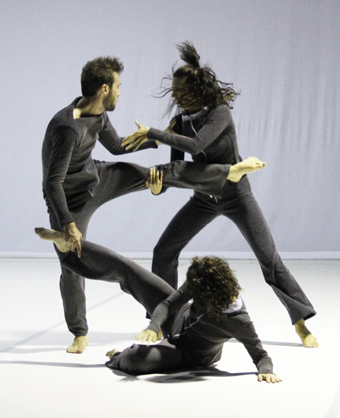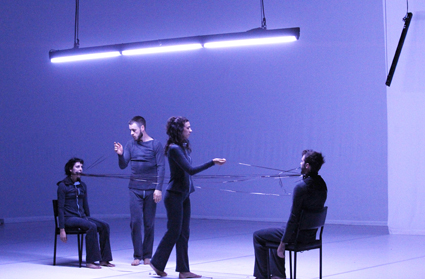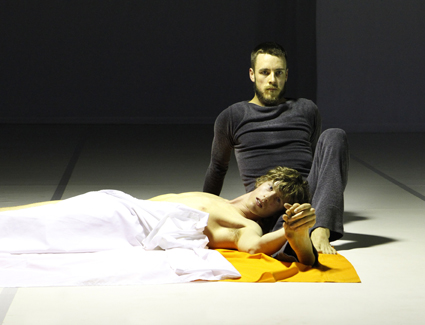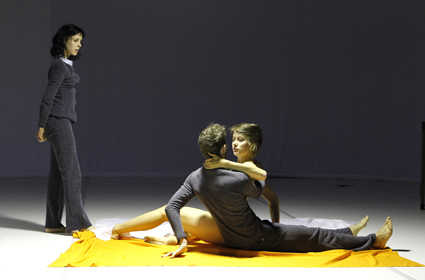March 29 2011
sounds massive
gail priest: the soundtracks of dance massive
the limits of the extraordinary
nilsson-polias: force majeure, not in a million years, dance massive
March 27 2011
let's dance—and we do
jana perkovic: bluemouth inc, dance marathon, dance massive
the unexploited
keith gallasch: antony hamilton, drift, dance massive
March 26 2011
post-apocalyptic drive-in dancing
carl nilsson-polias: antony hamilton, drift, dance massive
suspending self, time & disbelief
keith gallasch, virginia baxter: trevor patrick, i could pretend the sky is water, dance massive
talkin' 'bout my generation
philipa rothfield: becky, jodi & john, john jasperse company, dance massive
the truth of the matter, or not
jana perkovic: gideon obarzanek, faker, chunky move dance massive
March 24 2011
erupting from the archive
carl nilsson-polias: balletlab, amplification, dance massive
realtime video interview: trevor patrick
i could pretend the sky is water
March 23 2011
in the heat of the moment
keith gallasch: deanne butterworth, matthew day, dance massive
the ambiguities of happiness
jana perkovic: shaun parker, happy as larry, dance massive
March 22 2011
displacements: space, stage, workplace
keith gallasch: branch nebula's sweat & other works
present, tense
virginia baxter: luke george, now now now: dance massive
realtime video interview: luke george
now now now
March 20 2011
realtime video interview: gideon obarzanek
connected
realtime video interview: madeleine flynn & tim humphrey
music for imagined dances
realtime video interview: michelle heaven & brian lucas
disagreeable object
realtime video interview: rosalind crisp
no one will tell us...
March 19 2011
the poisoned pea
virginia baxter: michelle heaven, disagreeable object, dance massive
turning the tables, working the audience
carl nilsson-polias: sweat, branch nebula, dance massive
March 18 2011
dance like never before
keith gallasch: rosalind crisp, no one will tell us...; dance massive
the uneasy weight of metaphor
virginia baxter: shaun mcleod, the weight of the thing left its mark
March 17 2011
into the dance-scape
jana perkovic: narelle benjamin, in glass, dance massive
kinetics: sculpted & danced
carl nilsson-polias: connected, chunky move, dance massive
the art machine dances
keith gallasch: connected, chunky move, dance massive
March 16 2011
ghost dancing
keith gallasch: narelle benjamin, in glass, dance massive
journey of the tribe
jana perkovic: herbertson & cobham, sunstruck, dance massive
March 10 2011
kinetic art machine makes waves for dance
john bailey: reuben margolin & chunky move's connected
February 21 2011
dance massive 2011 artists: from the archive
force majeure, not in a million years; narelle benjamin, in glass, chunky move, faker; branch nebula, sweat; shaun mcleod, the weight of the thing left its mark: luke george, now, now, now; phillip adams amplification
the meeting point
sophie travers: steven richardson, dance massive
 |
Amplification, BalletLab
photo Jeff Busby |
IIN THE PERFORMING ARTS, MEMORY CAN BE SHORT. FASHIONS ARE FORGOTTEN, MISSTEPS ARE GLOSSED OVER, WHEELS ARE REINVENTED. IT IS THE BLESSING AND CURSE OF PRODUCING EPHEMERA. SO, WHEN A CHOREOGRAPHER UPSETS THE USUAL CYCLE OF MEMORY LAPSE BY RETURNING TO AN OLD WORK, WHAT IS THE RESULT? HOW DOES AN AUDIENCE PRIMED FOR IMMEDIACY RESPOND TO ARCHIVAL DISTANCE? WHAT DO WE SEE AND WHAT DO WE MISS?
Amplification is the work that launched BalletLab and Phillip Adams. Its premiere dates back to the far reaches of 1999. The same year, sanctions against Libya were dropped, something called Napster started and The Matrix opened. So, in some respects, Amplification is ancient history. Yet, here it is again, resurrected.
It is impossible to watch Amplification with eyes a decade younger—to see it now is to see it with the knowledge of what has come since. The problems this gives rise to are clear: the groundbreaking may now seem derivative, the accessible may now seem obscure and the noteworthy may now disappear into a fog of familiarity. However, the rewards are nevertheless there. Amplification holds its own if only because, while some of the style might seem dated, the expressive language remains distinct. Adams’ direction and choreography, in its metaphorical leaps and snowballing dramaturgy is unlike anything else at Dance Massive so far.
 |
Amplification, BalletLab
photo Jeff Busby |
It is possible to draw a worthwhile comparison here with German choreographer Sasha Waltz. Premiering only a few months later than Amplification, Waltz’s seminal Körper (seen recently at the 2009 Melbourne International Arts Festival,
RT94) has informed not only a decade of contemporary dance but also marked a fundamental moment of artistic expression for Waltz herself. In the subsequent years, Waltz has produced two other works—S and noBody—in response to Körper, making a trilogy of sorts that reflects her development as an artist as much as it does the development of the themes. Similarly, just over a year ago, Adams produced a response to Amplification called Miracle (
RT 93). And this year he produced a third instalment, Above.
 |
Amplification, BalletLab
photo Jeff Busby |
The most enticing conclusion to be drawn from this is that Amplification is an incomplete work. One that provokes questions rather than providing answers; one that leaves you wanting more; one that Phillip Adams has not finished exploring. This also suggests an excellent reason for a remount—for the audience to revisit a work with knowledge of its progeny.
Indeed, as someone who came to Miracle before Amplification, it is only possible to view the older work refracted through the lens of the newer. On the one hand, the distillation and evolution of Adams’ choreography in Miracle becomes evident—for instance, his increased trust in the dancers as embodiments rather than functionaries of his expression. On the other hand, cross-referenced understandings can be reached—for example, the common motif of the saffron cloth makes an overlong ritualistic swaddling of a corpse in Amplification ring with the memory of Miracle’s extraordinary final image of levitation.
Perhaps unsurprisingly for a choreographer, the locus for Adams’ artistic interest tends to be the body itself. But rather than the encyclopaedic vein of Waltz’s investigation in Körper, Adams is particularly focused on the extremities that the body can conquer, endure or suffer, which leads inevitably to the final extremity—mortality (like live performance, the body too is ephemeral).
 |
Amplification, BalletLab
photo Jeff Busby |
In Miracle, the body was a site for internal hysteria, a hindrance to be denied, a vessel to be exited. In Amplification, the violence enacted on the body comes from outside. The partnering work is fast and violent, bodies flung with disregard, Lynton Carr’s soundtrack an oppressive ceiling edging downwards. The space is never fully devoid of menace—the silhouetted torture scene is reminiscent of the disturbingly sterile violence of Romeo Castellucci’s Tragedia Endogonidia: BR.#04 Brussels (
RT 76), yet there are moments that almost break into the absurd—threatening toy cars roll towards the dancers, one scene mimics the tropes of horror films, another alludes to the symphorophilia of JG Ballard’s Crash.
In the end, the clearest point of contrast between Miracle and Amplification comes not in their exploration of the living body but in their vision of the afterlife. Miracle ended with a transcendent sleight of hand, a weightlessly impossible vision of the body in harmony with space. In Amplification, the body retains its mass. The afterlife here is one grounded in the body’s inescapability and so, one by one, the naked bodies of the dancers form a soft eternal landscape.
Dance Massive: Balletlab, Amplification, director, choreographer Phillip Adams, performers Timothy Harvey, Rennie McDougall, Carlee Mellow, Brooke Stamp & Joanne White, composer, turntablist Lynton Carr, set & lighting design Bluebottle, costumes Graham Green; Malthouse, Melbourne, March 22-26 , www.dancemassive.com.au
RealTime issue #102 April-May 2011 pg. 10
© Carl Nilsson-Polias; for permission to reproduce apply to [email protected]
Back to top












 back
back